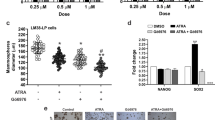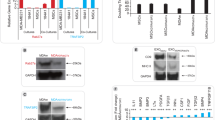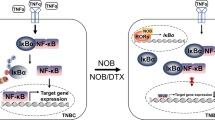Abstract
We hypothesized that specific activation of a single retinoic acid receptor-α (RARα), without direct and concurrent activation of RARβ and γ, will inhibit mammary tumor oncogenesis in murine models relevant to human cancer. A total of 50 uniparous mouse mammary tumor virus (MMTV)-neu and 50 nuliparous MMTV-wnt1 transgenic mice were treated with RARα agonist (retinobenzoic acid, Am580) that was added to the diet for 40 (neu) and 35 weeks (wnt1), respectively. Among the shared antitumor effects was the inhibition of epithelial hyperplasia, a significant increase (P<0.05) in tumor-free survival and a reduction in tumor incidence and in the growth of established tumors. In both models, the mechanisms responsible for these effects involved inhibition of proliferation and survival pathways, and induction of apoptosis. The treatment was more effective in the MMTV-wnt1 model in which Am580 also induced differentiation, in both in vivo and three-dimensional (3D) cultures. In these tumors Am580 inhibited the wnt pathway, measured by loss of nuclear β-catenin, suggesting partial oncogene dependence of therapy. Am580 treatment increased RARβ and lowered the level of RARγ, an isotype whose expression we linked with tumor proliferation. The anticancer effect of RARα, together with the newly discovered pro-proliferative role of RARγ, suggests that specific activation of RARα and inhibition of RARγ might be effective in breast cancer therapy.
This is a preview of subscription content, access via your institution
Access options
Subscribe to this journal
Receive 50 print issues and online access
$259.00 per year
only $5.18 per issue
Buy this article
- Purchase on Springer Link
- Instant access to full article PDF
Prices may be subject to local taxes which are calculated during checkout








Similar content being viewed by others
References
Astrom A, Pettersson U, Krust A, Chambon P, Voorhees JJ . (1990). Retinoic acid and synthetic analogs differentially activate retinoic acid receptor dependent transcription. Biochem Biophys Res Commun 173: 339–345.
Berry DC, Noy N . (2007). Is PPARbeta/delta a retinoid receptor? PPAR Res 2007: 73256.
Borriello A, Cucciolla V, Criscuolo M, Indaco S, Oliva A, Giovane A et al. (2006). Retinoic acid induces p27Kip1 nuclear accumulation by modulating its phosphorylation. Cancer Res 66: 4240–4248.
Brennan KR, Brown AM . (2004). Wnt proteins in mammary development and cancer. J Mammary Gland Biol Neoplasia 9: 119–131.
Bukholm IK, Nesland JM, Borresen-Dale AL . (2000). Re-expression of E-cadherin, alpha-catenin and beta-catenin, but not of gamma-catenin, in metastatic tissue from breast cancer patients [see comments]. J Pathol 190: 15–19.
Cardiff RD, Wellings SR . (1999). The comparative pathology of human and mouse mammary glands. J Mammary Gland Biol Neoplasia 4: 105–122.
Chambon P . (1996). A decade of molecular biology of retinoic acid receptors. FASEB J 10: 940–954.
Chapellier B, Mark M, Messaddeq N, Calleja C, Warot X, Brocard J et al. (2002). Physiological and retinoid-induced proliferations of epidermis basal keratinocytes are differently controlled. EMBO J 21: 3402–3413.
Clevers H . (2006). Wnt/beta-catenin signaling in development and disease. Cell 127: 469–480.
Collins SJ . (2008). Retinoic acid receptors, hematopoiesis and leukemogenesis. Curr Opin Hematol 15: 346–351.
Dankort DL, Muller WJ . (2000). Signal transduction in mammary tumorigenesis: a transgenic perspective. Oncogene 19: 1038–1044.
Debnath J, Muthuswamy SK, Brugge JS . (2003). Morphogenesis and oncogenesis of MCF-10A mammary epithelial acini grown in three-dimensional basement membrane cultures. Methods 30: 256–268.
Delescluse C, Cavey MT, Martin B, Bernard BA, Reichert U, Maignan J et al. (1991). Selective high affinity retinoic acid receptor alpha or beta-gamma ligands. Mol Pharmacol 40: 556–562.
Easwaran V, Pishvaian M, Salimuddin, Byers S . (1999). Cross-regulation of beta-catenin-LEF/TCF and retinoid signaling pathways. Curr Biol 9: 1415–1418.
Gantenbein-Ritter B, Potier E, Zeiter S, van der Werf M, Sprecher CM, Ito K . (2008). Accuracy of three techniques to determine cell viability in 3D tissues or scaffolds. Tissue Eng Part C Methods 14: 353–358.
Gianni M, Kopf E, Bastien J, Oulad-Abdelghani M, Garattini E, Chambon P et al. (2002). Down-regulation of the phosphatidylinositol 3-kinase/Akt pathway is involved in retinoic acid-induced phosphorylation, degradation, and transcriptional activity of retinoic acid receptor gamma 2. J Biol Chem 277: 24859–24862.
Hong WK, Lippman SM, Itri LM, Karp DD, Lee JS, Byers RM et al. (1990). Prevention of second primary tumors with isotretinoin in squamous-cell carcinoma of the head and neck. N Engl J Med 323: 795–801.
Kagechika H, Kawachi E, Hashimoto Y, Himi T, Shudo K . (1988). Retinobenzoic acids. 1. Structure-activity relationships of aromatic amides with retinoidal activity. J Med Chem 31: 2182–2192.
Kim AH, Khursigara G, Sun X, Franke TF, Chao MV . (2001). Akt phosphorylates and negatively regulates apoptosis signal-regulating kinase 1. Mol Cell Biol 21: 893–901.
Klaassen I, Brakenhoff RH, Smeets SJ, Snow GB, Braakhuis BJ . (2001). Metabolism and growth inhibition of four retinoids in head and neck squamous normal and malignant cells. Br J Cancer 85: 630–635.
Li Y, Welm B, Podsypanina K, Huang S, Chamorro M, Zhang X et al. (2003). Evidence that transgenes encoding components of the Wnt signaling pathway preferentially induce mammary cancers from progenitor cells. Proc Natl Acad Sci USA 100: 15853–15858.
Lin SY, Xia W, Wang JC, Kwong KY, Spohn B, Wen Y et al. (2000). Beta-catenin, a novel prognostic marker for breast cancer: its roles in cyclin D1 expression and cancer progression. Proc Natl Acad Sci USA 97: 4262–4266.
Lotan R . (1995). Retinoids and apoptosis: implications for cancer chemoprevention and therapy. J Natl Cancer Inst 87: 1655–1657.
Marcotte R, Muller WJ . (2008). Signal transduction in transgenic mouse models of human breast cancer—implications for human breast cancer. J Mammary Gland Biol Neoplasia 13: 323–335.
Moon RC, Mehta RG . (1990). Cancer chemoprevention by retinoids: animal models. Methods Enzymol 190: 395–406.
Mulholland DJ, Dedhar S, Coetzee GA, Nelson CC . (2005). Interaction of nuclear receptors with the Wnt/beta-catenin/Tcf signaling axis: Wnt you like to know? Endocr Rev 26: 898–915.
Muller WJ, Sinn E, Pattengale PK, Wallace R, Leder P . (1988). Single-step induction of mammary adenocarcinoma in transgenic mice bearing the activated c-neu oncogene. Cell 54: 105–115.
Nelson WJ, Nusse R . (2004). Convergence of Wnt, beta-catenin, and cadherin pathways. Science 303: 1483–1487.
Noy N . (2007). Ligand specificity of nuclear hormone receptors: sifting through promiscuity. Biochemistry 46: 13461–13467.
Osanai M, Petkovich M . (2005). Expression of the retinoic acid-metabolizing enzyme CYP26A1 limits programmed cell death. Mol Pharmacol 67: 1808–1817.
Ozpolat B, Mehta K, Tari AM, Lopez-Berestein G . (2002). All-trans-retinoic acid-induced expression and regulation of retinoic acid 4-hydroxylase (CYP26) in human promyelocytic leukemia. Am J Hematol 70: 39–47.
Paik J, Blaner WS, Sommer KM, Moe R, Swisshlem K . (2003). Retinoids, retinoic acid receptors, and breast cancer. Cancer Invest 21: 304–312.
Patatanian E, Thompson DF . (2008). Retinoic acid syndrome: a review. J Clin Pharm Ther 33: 331–338.
Polakis P . (2000). Wnt signaling and cancer. Genes Dev 14: 1837–1851.
Purton LE, Dworkin S, Olsen GH, Walkley CR, Fabb SA, Collins SJ et al. (2006). RARgamma is critical for maintaining a balance between hematopoietic stem cell self-renewal and differentiation. J Exp Med 203: 1283–1293.
Radu M, Soprano DR, Soprano KJ . (2008). S10 phosphorylation of p27 mediates atRA induced growth arrest in ovarian carcinoma cell lines. J Cell Physiol 217: 558–568.
Ryo A, Nakamura M, Wulf G, Liou YC, Lu KP . (2001). Pin1 regulates turnover and subcellular localization of beta-catenin by inhibiting its interaction with APC. Nat Cell Biol 3: 793–801.
Schneider SM, Offterdinger M, Huber H, Grunt TW . (2000). Activation of retinoic acid receptor alpha is sufficient for full induction of retinoid responses in SK-BR-3 and T47D human breast cancer cells. Cancer Res 60: 5479–5487.
Schug TT, Berry DC, Shaw NS, Travis SN, Noy N . (2007). Opposing effects of retinoic acid on cell growth result from alternate activation of two different nuclear receptors. Cell 129: 723–733.
Shin DM, Khuri FR, Murphy B, Garden AS, Clayman G, Francisco M et al. (2001). Combined interferon-alfa, 13-cis-retinoic acid, and alpha-tocopherol in locally advanced head and neck squamous cell carcinoma: novel bioadjuvant phase II trial. J Clin Oncol 19: 3010–3017.
Slamon DJ, Clark GM, Wong SG, Levin WJ, Ullrich A, McGuire WL . (1987). Human breast cancer: correlation of relapse and survival with amplification of the HER-2/neu oncogene. Science 235: 177–182.
Sporn MB, Dunlop NM, Newton DL, Smith JM . (1976). Prevention of chemical carcinogenesis by vitamin A and its synthetic analogs (retinoids). Fed Proc 35: 1332–1338.
Su D, Gudas LJ . (2008). Gene expression profiling elucidates a specific role for RARgamma in the retinoic acid-induced differentiation of F9 teratocarcinoma stem cells. Biochem Pharmacol 75: 1129–1160.
Tsukamoto AS, Grosschedl R, Guzman RC, Parslow T, Varmus HE . (1988). Expression of the int-1 gene in transgenic mice is associated with mammary gland hyperplasia and adenocarcinomas in male and female mice. Cell 55: 619–625.
Van Heusden J, Wouters W, Ramaekers FC, Krekels MD, Dillen L, Borgers M et al. (1998). All-trans-retinoic acid metabolites significantly inhibit the proliferation of MCF-7 human breast cancer cells in vitro. Br J Cancer 77: 26–32.
Veeck J, Bektas N, Hartmann A, Kristiansen G, Heindrichs U, Knuchel R et al. (2008a). Wnt signalling in human breast cancer: expression of the putative Wnt inhibitor Dickkopf-3 (DKK3) is frequently suppressed by promoter hypermethylation in mammary tumours. Breast Cancer Res 10: R82.
Veeck J, Noetzel E, Bektas N, Jost E, Hartmann A, Knuchel R et al. (2008b). Promoter hypermethylation of the SFRP2 gene is a high-frequent alteration and tumor-specific epigenetic marker in human breast cancer. Mol Cancer 7: 83.
Vidal A, Koff A . (2000). Cell-cycle inhibitors: three families united by a common cause. Gene 247: 1–15.
Walkley CR, Olsen GH, Dworkin S, Fabb SA, Swann J, McArthur GA et al. (2007). A microenvironment-induced myeloproliferative syndrome caused by retinoic acid receptor gamma deficiency. Cell 129: 1097–1110.
Warrell Jr RP, de The H, Wang ZY, Degos L . (1993). Acute promyelocytic leukemia. N Engl J Med 329: 177–189.
White JA, Beckett-Jones B, Guo YD, Dilworth FJ, Bonasoro J, Jones G et al. (1997). cDNA cloning of human retinoic acid-metabolizing enzyme (hP450RAI) identifies a novel family of cytochromes P450. J Biol Chem 272: 18538–18541.
Wolbach SB, Howe PR . (1925). Nutrition classics. J Exp Med 42: 753–777.
Wolbach SB, Howe PR . (1978). Tissue changes following deprivation of fat-soluble A vitamin. Nutr Rev 36: 16–19.
Wolf G, Smas CM . (2000). Retinoic acid induces the degradation of the leukemogenic protein encoded by the promyelocytic leukemia gene fused to the retinoic acid receptor alpha gene. Nutr Rev 58: 211–214.
Wu JM, DiPietrantonio AM, Hsieh TC . (2001). Mechanism of fenretinide (4-HPR)-induced cell death. Apoptosis 6: 377–388.
Acknowledgements
We thank Drs W Muller and HE Varmus, respectively, for the gift of MMTV-neu and MMTV-wnt1 mice, Dr K Shudo for generous gift of AM580 in amounts sufficient to complete these extensive in vivo studies, and Drs L Ossowski, S Waxman and J Aguirre-Ghiso for helpful advice. This work was supported by the NCI Grant R01-CA119018, the Samuel Waxman Cancer Research Foundation (SWCRF) and the NIH-NCI shared resources Grant 5R24-CA095823-04, NSF Major Research Instrumentation Grant DBI-972404, the NIH shared instrumentation Grant 1S10-RR0-9145-01 to MSSM's Microscopy Shared Resources Facility.
Author information
Authors and Affiliations
Corresponding author
Ethics declarations
Competing interests
The authors declare no conflict of interest.
Additional information
Supplementary Information accompanies the paper on the Oncogene website
Supplementary information
Rights and permissions
About this article
Cite this article
Lu, Y., Bertran, S., Samuels, TA. et al. Mechanism of inhibition of MMTV-neu and MMTV-wnt1 induced mammary oncogenesis by RARα agonist AM580. Oncogene 29, 3665–3676 (2010). https://doi.org/10.1038/onc.2010.119
Received:
Revised:
Accepted:
Published:
Issue Date:
DOI: https://doi.org/10.1038/onc.2010.119
Keywords
This article is cited by
-
Cellular and micro-environmental responses influencing the antitumor activity of all-trans retinoic acid in breast cancer
Cell Communication and Signaling (2024)
-
Neuroblastoma SH-SY5Y Cell Differentiation to Mature Neuron by AM580 Treatment
Neurochemical Research (2022)
-
Retinoic acid receptor alpha is associated with tamoxifen resistance in breast cancer
Nature Communications (2013)
-
Reversal by RARα agonist Am580 of c-Myc-induced imbalance in RARα/RARγ expression during MMTV-Myc tumorigenesis
Breast Cancer Research (2012)
-
Role of the retinoic acid receptor-α in HIV-associated nephropathy
Kidney International (2011)



